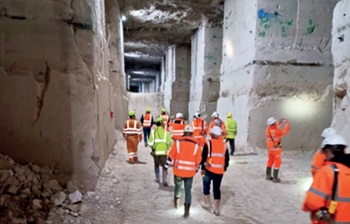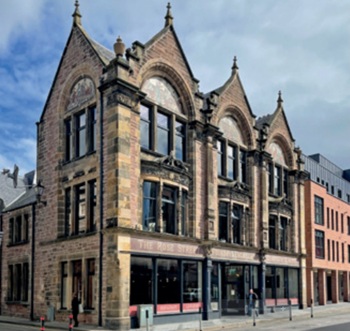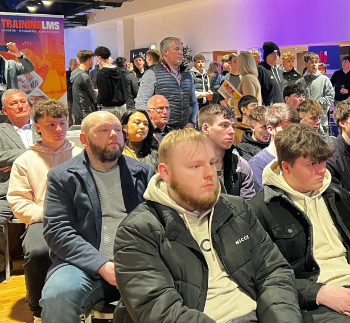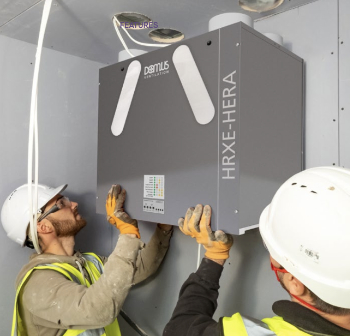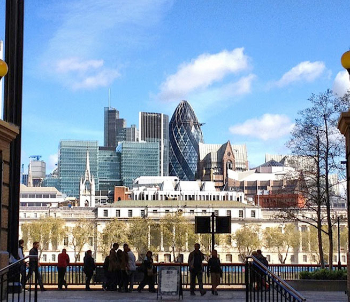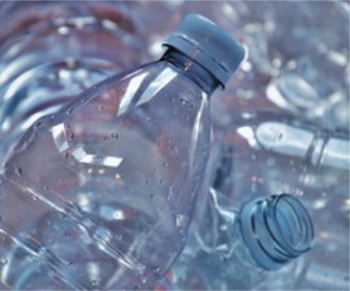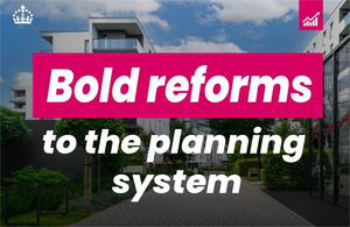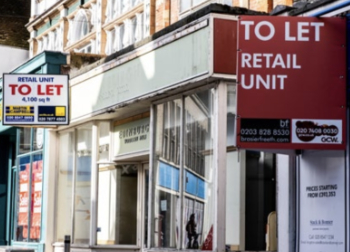Top nine ideas for a more sustainable food factory

|
Food processing facilities often have a much higher water and carbon footprint than other building types. This is not only due to their size but is also attributed to their energy-intensive equipment, such as cold storage and/or pasteurisation, and their strict food-safety regimes for cleaning and sanitation.
This article explores nine key ideas and numerous sustainable design opportunities through which food factories can minimise environmental impact, improve working conditions and strive for carbon neutrality.
[edit] Energy demand reduction
Food factories are energy guzzlers requiring exceptional amounts of energy to mass-produce food for supermarket shelves. Their major energy hitters are processing equipment, including production lines’ operation and cleaning, and general factory operations, including space conditioning, ventilation and lighting. Each major contributor comprises many individual energy users, with diverse use-profiles and requirements. And while quick wins on energy demand reduction can be identified by considering each contributor individually, greater energy efficiency opportunities arise when considering the full energy demand profiles of the factory, and when investigating the interdependencies among its significant energy uses.
[edit] Process energy demand reduction
Industrial production usually requires some form of process heating for activities such as distillation, evaporation, drying, etc. Process heating operations are responsible for approximately 70% of the manufacturing sector’s energy use, while the food industry is estimated to account for about 26% of the EU’s total energy consumption. Capturing waste heat can save money and energy, and can be achieved through various waste heat recovery (WHR) technologies. WHR systems consist of heat exchangers and can be built into a new plant or retrofitted to existing plants. It is estimated that – depending on the process – energy wastage from freezing and canning in fruit and vegetable processing is between 10% and 45%. With rising fuel costs, estimates show WHR payback periods are as low as two to three years. Additionally, the use of economisers in boiler systems can increase the efficiency by 1% for every 5°C reduction of flue gas temperature. This indicates that the system’s fuel consumption can be reduced by 5–10% with a payback period of less than two years.
Other opportunities to reduce the energy demand of process heat include maximising utilisation, minimising evaporative losses through good insulation, metering, monitoring and regular maintenance.
[edit] Factory energy demand reduction
Factories are energy-intensive buildings. They tend to be spaces of high volume, with sensitive temperature setpoints and high mechanical ventilation rates and lighting requirements throughout their operating hours.
Warehouses and vehicle loading can be major sources of heat losses. While provision of lobbies and strip curtains, air locks, or insulated shutter doors can reduce heat loss, even greater benefits can be achieved by coupling vehicles to buildings by a dock seal, notably when coupled to a temperature-controlled loading bay or holding area.
Placing rooms with low temperature setpoints, or containing cold storage, adjacent to one another, or increasing internal wall insulation to minimise heat transfer, can lead to significant energy demand reductions, considering the 24/7 cooling requirements for key ingredients and products.
Careful and selective glazing positioning can provide significant wellbeing and energy benefits in large factory spaces. Rather than providing good levels of natural light throughout a facility (which given the higher U-values of glazing compared to solid walls can lead to significant reduction in thermal performance), it is sensible to prioritise glazing in areas where operatives are working, if food safety permits. This includes packing areas and above engineers' workstations, rather than areas of automated processing lines, where operatives are just passing through for quality checks.
[edit] Balanced energy distribution
Typically, factory cooling is provided using chillers, whose waste heat output would be rejected into the atmosphere, and heating is generated from a separate system, thereby creating an open jaw duplication of energy generation. Food factories have a unique energy characteristic: they generally require both heat and coolth in large quantities at the same time or within a reasonable buffer range. This presents the opportunity to introduce a closed loop waste-heat recovery system which uses the cooling waste heat to preheat air or water, and, consequently, reduce the factory’s heating demand.
Additional energy balancing opportunities comprise pre-cooling/heating of spaces at times of low-power demand, such as during night shifts.
[edit] Low and zero carbon technologies
Factories are typically located in low-density industrial areas with low-rise buildings, and good distribution links. The low density of their surrounds may prove ideal for large scale wind turbines, thereby improving the local renewable energy infrastructure, and offering a zero-carbon energy source for the factories.
Considering the sheer size and footprint of many factories, their extensive roof area is perfect for roof-mounted photovoltaic (PV) arrays. Coupling the PVs with a green roof can also improve the building's thermal performance and provide a more thermally comfortable environment, thereby reducing winter heating and summer cooling needs and costs.
[edit] Hidden carbon
When people think of carbon, they usually think of gas and electricity consumption. Maybe, some think about cows farting too, as one tonne of methane has the same global warming potential (GWP) as 28 tonnes of carbon. But there are other colourless, odourless gases in buildings which we tend to overlook: refrigerants.
Modern cooling systems can use multiple refrigerants, with hydrofluorocarbons (HFCs) being the norm, since they replaced the pesky chlorofluorocarbons (CFCs), responsible for the ozone hole and banned under the Montreal Protocol 1987. However, these refrigerants often have a high GWP of over 1400, and even those deemed “low GWP”, such as the HFOs (Hydroflouro Olefins) often need to be blended with HFCs for commercial application thereby leading to coolants with a GWP of around 1,000.
But the GWP of the refrigerants is only an issue if they escape the system and leak into the atmosphere, but therein lies the problem, as annual gas-leak rates in refrigeration systems can be around 25%.
Natural refrigerants such as ammonia and hydrocarbon with no or negligible GWP are available in commercial systems and can operate in temperature ranges far greater than their alternatives. The added benefit of this is that heat pump solutions using such refrigerants can operate in higher temperatures, and therefore, become more attractive for industrial installations.
[edit] Design for future factory expansion, product adaptability and facility flexibility
Due to the value of assets and bespoke nature of production, factories are typically owned and operated over a long lifetime. It is therefore in the best interest of the organisation to futureproof the facility to be able to respond to changing customer demands, including factory expansion, product adaptations or future regulations e.g. packaging restrictions.
Avoiding functional obsolescence requires careful planning and holistic decision making in the very early design stages.
Most importantly, all ‘permanent’ factory elements which are expected to remain over its entire lifetime and not require replacement – foundations and structural frame – should be designed to accommodate potential future loadings, equipment replacement and factory expansion.
Designing-in the ability to expand in the future not only means leaving the necessary space on the site, but also means selecting façade systems which can be easily removed and reused post expansion and potentially designing-in extra capacity at structural connection points to reduce the need for structural reinforcing post-expansion. Designing for future expansion requires keeping good records of the structural capacity, materiality and as-built design. Material passport software such as 'Buildings as Material Banks' or 'Madaster' can be integrated into the project BIM model to record all construction information necessary to enable future low-impact renovation or deconstruction.
[edit] People-focused factories – health and wellbeing of employees
Factories are typically perceived as sterile, dismal, equipment-focused facilities with little consideration for the people who work in them. With the rise of robotics and automation in the food industry, the number of factory workers, in particular with repetitive, low-skilled roles have reduced. However, a modern food factory will still have essential roles such as engineers, quality control technicians, logistics coordinators, cleaners, packers and forklift drivers.
The remote, often noisy and low-employee density of food factory operations makes it even more important to incorporate quiet 'oases' within the design. Providing wellness areas with access to daylight and views out, amenity spaces and a canteen offering healthy food options for employee use, supports informal interaction between employees, thereby promoting a sense of community and improving productivity.
Even seemingly small things like ensuring factory and office staff use the same entrance on a daily basis can have a significant impact on employee health and happiness
[edit] Water footprinting
As with the factory energy profile, the vast majority of factories’ water demand is driven by the process operations. Unlike the term carbon footprint, water footprint is still a relatively new concept, and one which is possibly more challenging to quantify and tackle than a carbon footprint, as the impact of any water use will vary, depending on the local availability of freshwater. Common water-hungry factory processes include cleaning of distribution lines and processing equipment, transportation of easily bruising food, and continuous water cooling of equipment. Opportunities to reduce water demand in the first instance include ice pigging to clean the inside of pipes and tubing. Ice-pigging helps reduce the use of harmful cleaning fluids, requires less water than standard pigging, saves time, improves process efficiency and ultimately increases profits.
A strategy for the local treatment and recycling that considers both the output quality of used water and the input water quality parameters can enable water reuse without excessive, energy intensive treatment and reduce loading on the local sewage system.
[edit] Circular Economy
The Circular Economy is a sustainability headline on the rise across many industries, as businesses are looking to address the systemic issues behind our current linear economy, based on a 'take, make, waste' mentality. For the built environment, this means creating regenerative building designs that prioritise adaptability and the reuse of waste materials and components, while stimulating the local economy and creating new industries in the process. Some of the key themes which can be applied to the food production industry are: avoiding the use of composite, non-recyclable, or virgin materials, identifying local recycling routes and engaging with the supply chain to promote packaging reuse or development of take-back schemes.
[edit] Employee transportation
Factories can be located in remote areas with limited access to sustainable transportation options, meaning employees and visitors access factories via single-person vehicles. Following assessment of the surrounding transport infrastructure and the existing barriers to using sustainable transportation, food factories can be designed to accommodate and promote the use of alternative transport. For example, by designing safe access routes for bicycles, providing electric vehicle charging stations or running a shuttle from the nearest public transport link, factory infrastructure can support the use of sustainable transport. Additionally, by promoting active travel via incentives such as a cycle to work scheme or a carpooling points system, a factory can reduce the number of vehicles on the road, thereby reducing congestion, carbon emissions and improving air quality.
--KLH Sustainability 12:22, 08 Aug 2019 (BST)
[edit] Related articles on Designing Buildings Wiki
- Carbon ratings for buildings.
- Circular economy.
- CRC Energy Efficiency Scheme.
- Display energy certificate.
- Do green buildings pay?
- Energy certificates for buildings.
- Energy targets.
- Environmental - sustainable - green design.
- Green rating systems.
- Green supply chain management.
- Kevin McCloud's 'Green Heroes' 2019
- Performance gap.
- Sustainability.
- Wellbeing.
- Zero carbon non-domestic buildings.
Featured articles and news
An architectural movement to love or hate.
Don’t take British stone for granted
It won’t survive on supplying the heritage sector alone.
The remarkable story of a Highland architect.
The Constructing Excellence Value Toolkit
Driving value-based decision making in construction.
Meet CIOB event in Northern Ireland
Inspiring the next generation of construction talent.
Reasons for using MVHR systems
6 reasons for a whole-house approach to ventilation.
Supplementary Planning Documents, a reminder
As used by the City of London to introduce a Retrofit first policy.
The what, how, why and when of deposit return schemes
Circular economy steps for plastic bottles and cans in England and Northern Ireland draws.
Join forces and share Building Safety knowledge in 2025
Why and how to contribute to the Building Safety Wiki.
Reporting on Payment Practices and Performance Regs
Approved amendment coming into effect 1 March 2025.
A new CIOB TIS on discharging CDM 2015 duties
Practical steps that can be undertaken in the Management of Contractors to discharge the relevant CDM 2015 duties.
Planning for homes by transport hubs
Next steps for infrastructure following the updated NPPF.
Access, history and Ty unnos.
The world’s first publicly funded civic park.
Exploring permitted development rights for change of use
Discussing lesser known classes M, N, P, PA and L.
CIOB Art of Building photo contest 2024 winners
Fresco School by Roman Robroek and Once Upon a Pass by Liam Man.









